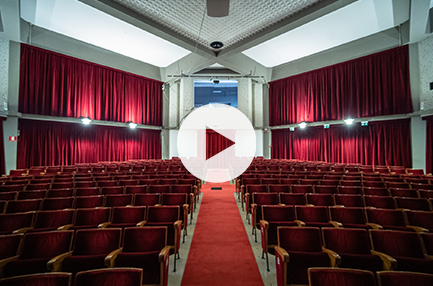Theatres, cinemas and cultural hotspots in Porta Romana
One thing that Porta Romana is not short of is theatres, avant-garde cinemas, concert halls and venues for signings. It is a fascinating neighbourhood in artistic and intellectual terms. Here is a brief tour that will acquaint you with the buzziest cultural hotspots which have now become polestars for the entire city of Milan.
The Franco Parenti Theatre
The most famous local theatre is the Franco Parenti. Founded in 1972 under the name of Salone Pier Lombardo (from the name of the street it stood in) by Andrée Ruth Shammah, Franco Parenti, Giovanni Testori, Dante Isella and Gian Maurizio Fercioni, it was modern from the moment of its inception. Not only did it offer its audience theatre shows, but also music, cinema viewings, play talks and exhibitions.

It soon became a cultural touchstone for the city and took the name of the accomplished actor Franco Parenti in 1989. When he died, Andrée Ruth Shammah took the helm of the theatre by herself.
Since then, theatre director Shammah has continued to work with leading lights from the Thespian world and young talent alike. She has put on over one hundred plays, launching new authors and performers, and offering her own thought-provoking take on topical issues and classic shows.
The Bagni Misteriosi
Fired by the same innovative spirit and with the support of thousands of Milanese citizens belonging to the Pier Lombardo Foundation, Andrée Ruth Shammah initiated and undertook the artistic direction for the redevelopment of the entire complex now known today as the Franco Parenti Theatre – Bagni Misteriosi – one of the most remarkable cultural hotspots in the whole of Italy.
The first step involved renovating the premises of the Theatre under the direction of Michele De Lucchi. In 2008, it became the first “multi-hall” theatre in Italy and a non-stop playhouse with spaces and auditoriums of varying capacities.
The second phase of the work salvaged the Centro Balneare Caimi (a complex of pools) which is a gem of rationalist architecture that is listed due to its intrinsic historical value. Condemned and shut down by the Municipality of Milan, it was revamped and reconnected to the Theatre according to an original 30s project, becoming the Bagni Misteriosi that we know today. Since 2016, it has been a haven of beauty for the pleasure of everyone and even includes a new platform for concerts, shows and poolside events.
The Cinemino of Porta Romana
A few metres away from the Franco Parenti and the Bagni Misteriosi stands a cult-worthy place that draws people like a magnet: The Cinemino. Set up in 2018 as a cultural gathering place, the Cinemino has a screening room with 74 seats, an interesting programme of events and a small bar which is split into two attractively-decorated areas.
The Cinemino organises a great many projects, most of which, obviously, regard the cinema, but not all of them. Film screenings are reserved for members only, but it is easy enough to join. On the other hand, the bar is open to the general public from morning to night and will allow you to soak up the culturally-rich but informal atmosphere and enjoy the sophisticated setting while you chat with friends or colleagues.
The Teatro Oscar
Last but by no means least in terms of importance, we have the Oscar Theatre in via Lattanzio. It used to be a parish playhouse and theatre linked to the Church of San Pio V & S. Maria di Calvairate, but in 1969 it made an exciting move and became a film club – which is what we are lucky enough to enjoy today.

For the last few years, the Theatre has been run by three friends with years of experience in the show business and culture sector: Giacomo Poretti (“the 33.3% of the trio Aldo Giovanni & Giacomo” as he likes to define himself) who also acts as artistic director, Luca Doninelli and Gabriele Allevi.
These three men have transformed this place with their enthusiasm and love for the Thespian world and it is now the scene of action for the project called: “deSidera”. The concept behind this project stems from a cultural festival that originated in Bergamo more than 15 years ago.
Each piece gets us to think about our desires and look within our hearts because these are the driving forces that push us through this journey called life.
Discover more







